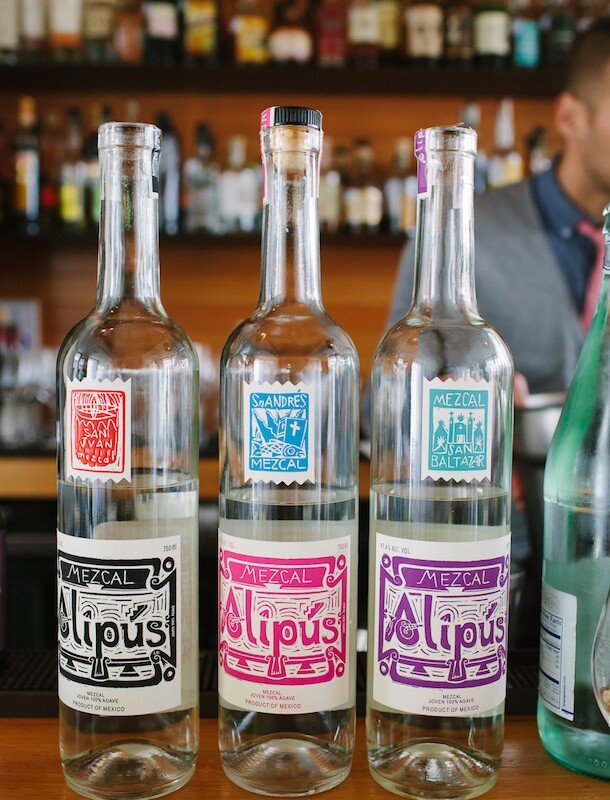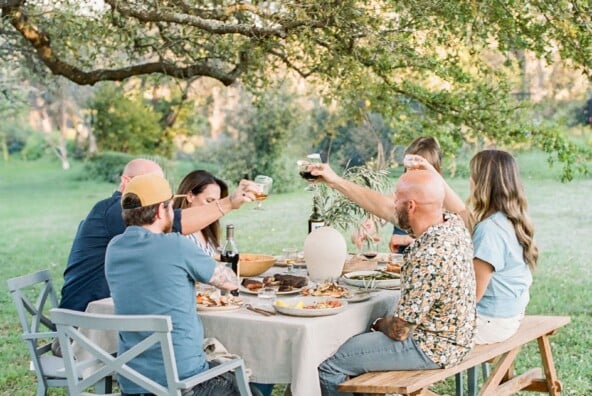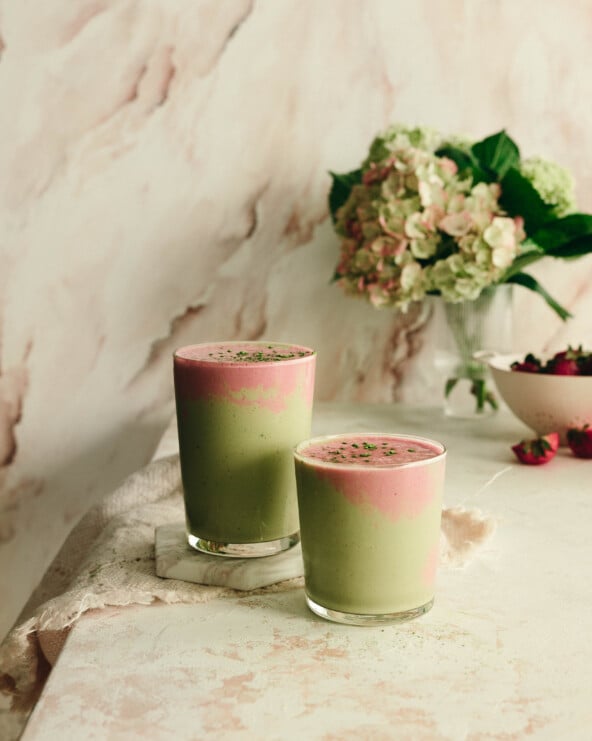Two weekends ago, a few of us got together for the ultimate Sunday Funday. While I’m typically content with Bloody Marys and Mimosas, I was excited to step things up a notch with a few of the lovely ladies from our team for an afternoon of mezcal tasting at Austin’s newest hotspot, qui. With the help of qui’s PR & events guru Deana Saukam, bar manager Michael Simon hosted us for a hands-on lesson in all things mezcal. If you’re asking yourself, What is mezcal? Don’t worry, you’re not alone. Click through for everything you need to know about Mexico’s finest export, accompanied by gorgeous photos by Wynn Myers.

How gorgeous is the bar? Open six nights a week, it’s the perfect spot to grab pre-dinner drinks.

Deana prepped the space for the ultimate tasting experience. With tasting glasses poured and ready to go, I couldn’t help but notice the smoky aroma of the mezcal in the air as soon as I entered the bar area.

We each received one of these lovely monogrammed Mirth & Co notebooks to jot down our notes from the day — the same notebooks that the qui waitstaff uses when serving.

Though mezcal is traditionally consumed straight, I was delighted to learn that our first sip of the day would be in the form of a citrusy mixed drink. We kicked things off with my favorite cocktail on the Qui menu, The Iron Price (Alipus San Andres Mezcal, dolin rouge, grapefruit, orchard cherry, yuzu tincture and mole bitters) topped with sparkling Pinot Noir. Totally unexpected and completely delicious.

Mezcal is made in Oaxaca, Mexico from the native agave plant. It takes anywhere from 8 to 14 years for an agave plant to be usable for mezcal, which results in maturity and flavor, but often very low yields.
The taste of the mezcal depends greatly on the terroir of each individual agave. Think: grapes are to wine, as agave is to mezcal.
*terroir: the complete natural environment in which a plant is produced

Once the agave plant is usable, it must be hacked out of the ground. The heart of the agave plant (called the piña) is roasted for 3-5 days in a pit oven — this slow cooking gets the most out of the agave’s sugars and gives mezcal its distinctive smoky flavor.
The piña is then ground and crushed in a large grindstone, rinsed with spring water, and left to ferment with water in large barrels or vats. The resulting liquid is then distilled twice to raise the alcohol percentage.
The entire mezcal making process is unadulterated enough to where you’re drinking something that’s completely pure and from the earth.

Michael told us that the Alipus Family of mezcals has been an invaluable addition to the US market. From Oaxaca’s famous mezcal region of Puebla, they focus heavily on craft production in artisanal family distilleries and showcase a high quality product that’s affordable, accessible and perfect for making craft cocktails… and we love the labels!
From left to right: Alipus San Juan Del Rio; Alipus San Andres; Alipus San Baltazar Guelavila

I love the stools that One Eleven Design sourced for the space. These are the Machinist Stool in white from Industry West.

Only 606 bottles of Mezcalero 7th Release were produced. Distinguished by the inclusion of scarce agaves, this line is difficult to collect and transport, distinctively flavored, and rich in character.

Los Nahuales Reposado is made from Agave Espadin (the most widely cultivated & produced agave) and aged in French Oak for six months, giving it its amber color.
*reposado = aged

After each swirl, smell and sip, we discussed the quality, feel and flavors detected. Floral notes! Citrus flavors! Overripe bananas! We learned that there’s no wrong answer.

Mezcal Old Fashioned
- 2 oz. Alipus San Baltazer Mezcal
- .75 oz Dill & Coconut Agave
- .25 oz The Bitter Truth Allspice Liqueur
- 3 Shake Mole Bitters
- 1 large-ish slice of grapefruit (for muddling)
- combine dill & coconut agave, bitter and grapefruit in a large mixing glass and muddle gently
- add remaining ingredients, then fill halfway with ice
- stir gently for 20-30 seconds until the glass is cold to the touch
- strain into an old-fashioned glass over large ice cubes
- garnish with a wide-cut grapefruit peel

Toast like a true Mezcalero by chanting:
“Arriba! Abajo! Al centro, y pa’dentro!”
… which translates to (and corresponds with the motions) “Glasses up! Glasses down! Glasses to the center, and glasses in (as you drink)!”

Michael sent each of us home with a vial of dill & coconut agave for mixing up our own Mezcal Old Fashioneds at home.

Special thanks to qui, Deana Saukam, Michael Simon, Wynn Myers, Alipus, Mezcalero & Los Nahulaes!

photography by Wynn Myers







This looks like so much fun! And both cocktails he whipped up for you guys sound amazing!
-Heath
What a fun tasting concept – a unique idea compared to a typical wine or beer tasting event! Mezcal has made its way onto my to-try list or to maybe even incorporate into one of my upcoming events! Thanks for the tips, Chanel & Camille!
This looks like it was a lot of fun!
such a great concept! the cocktails sound absolutely delicious. looks like a lovely night 🙂
Molly {Dreams in HD}
http://dreamsinhd.blogspot.com/
The bar stools, the pop of color decor on the bottles… perfection!!
While not a fan of mezcal, I would put a few of those bottles in my bar for the look alone.
So fun!! This post has really convinced me to go to a mezcal tasting/class once and for all. I just haven’t been able to wrap my head around this new trend… I grew up in Mexico (Puebla) and mezcal was never something you would order at a nice bar, serve at parties or give as a gift. I think that’s because it was considered one of the cheapest forms of liquor and reserved more for those who couldn’t afford a good drink (or had a very raw palate). I am terribly curious to learn of how this shift came to happen, and whether it has also taken place in Mexico; or whether it’s only on this side of the border that people have been able to change their minds and be convinced to pay a much higher price tag. Definitely something very interesting to learn about both here and on my next trip back home.
That’s so interesting, Maya! While I’m also unsure of how this shift came to be, I’d be curious to learn more about it. One thing is certain… mezcal is definitely suited for a raw palate 🙂 Please let us know if you get any more information, and thanks for sharing! xo
Totally agree with you Maya! I grew up in Monterrey and the thought of Mezcal makes me cringe. It’s not a smooth spirit made for sipping from what I understand. It’s basically Mexico’s moonshine! How and why it’s becoming trendy? No clue… It’s going to take me a little more convincing to accept this one.
Ooh what a nice way to celebrate life with your closest girlfriends! I’ve never heard of Mezcal till now; it’s going on my bucket list 🙂
Cheers!
Akshara
Simply Akshara
super fun!
Oh I love wine tasting and this is a great spin on the traditional sense. Would love to give it a go! And that setting…wow….what a perfect way to have this kind of wine tasting party. The whole event looked super chilled and fun 🙂
This looks so fun! I want to go to Qui too!